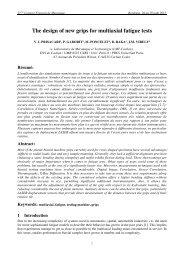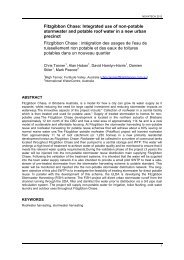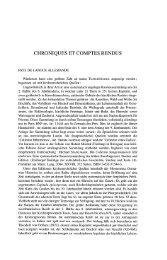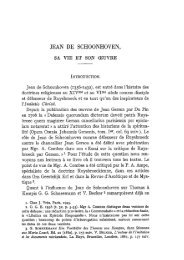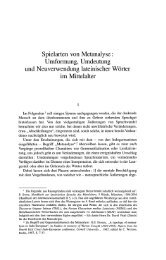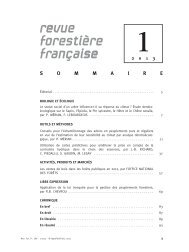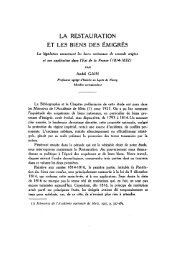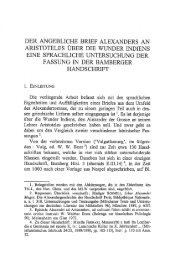ALDHELMI CARMEN RHYTHMICUM `
ALDHELMI CARMEN RHYTHMICUM `
ALDHELMI CARMEN RHYTHMICUM `
Create successful ePaper yourself
Turn your PDF publications into a flip-book with our unique Google optimized e-Paper software.
<strong>ALDHELMI</strong> <strong>CARMEN</strong> <strong>RHYTHMICUM</strong> `<br />
The first Englishman, indeed the first man of any Germanic<br />
nation, to become a Latin author, was the most brilliant alumnus<br />
of the school of Theodore Archbishop of Canterbury and<br />
Hadrian Abbot of Saints Peter and Paul, Canterbury . Aldhelm<br />
was born about 639 or 640, son of Kenten, perhaps Centwine,<br />
an otherwise unknown brother of Ine King of the West Saxons<br />
688-726, educated by the Irish philosopher and monk<br />
Maeldubh, then by Theodore and Hadrian sometime between<br />
670 and 675 . Elected Abbot of Malmesbury about 675, he was<br />
from his elevation in 705 until his death in 709 first Bishop of<br />
Sherborne.<br />
The following text of Aldhelmi Carmen Rhythmicum is based<br />
upon the only extant manuscript, Vienna, Österreichische<br />
Nationalbibliothek 751 folio 40', copied in the middle of the<br />
ninth century, apparently from materials assembled by the successor<br />
of Saint Boniface as Archbishop of Mainz 754-86, Lul,<br />
who had been a monk at Malmesbury . 2 In the manuscript each<br />
couplet occupies a single line with the verses arranged in two<br />
left justified columns . Here each couplet occupies two lines.<br />
1. I owe thanks for helpful criticism to Dr Leofranc Holford-Strevens and<br />
Dr Andy Orchard.<br />
2. For a facsimile of the unique manuscript see F . UNTERKIRCHER, Sancti<br />
Bonifacii Epistolae. Codex Vindobonensis 751 der österreichischen Nationalbibliothek,<br />
Codices Selecti Phototypice Impressi XXIV (Graz 1971) . For the<br />
standard edition see R . EHWALD, Aldhelmi Opera Omnia, Monuments Germaniae<br />
Historica, Auctores Antiquissimi XV (Berlin 1919) 523-8. For a translation<br />
see M. Lapidge & J. L. Rosier, Aldhelm, The Poetic Works (Cambridge<br />
1985) 169-79, 259-63. For secondary literature and analysis see H . BRADLEY,<br />
On Some Poems Ascribed to Aldhelm ', English Historical Review XV<br />
(1900) 291-2, and A . ORCHARD, The Poetic Art of Aldhelm, Cambridge Studies<br />
in Anglo-Saxon England VIII (Cambridge 1994) 17-72 .
120 D. R . HOWLETT<br />
Other departures from the manuscript are noted below 3 and<br />
after the text. To the left of the text are line numbers . Within<br />
the text capital letters and punctuation marks in boldface represent<br />
litterae notabiliores and marks of the manuscript . Rhymes<br />
are marked by italics. Alliteration within lines and between<br />
adjacent lines is marked by solid underline . Alliteration between<br />
alternate lines is marked by dotted underline . To the right of the<br />
text the first column notes the scheme of rhymes ; the second<br />
column notes the scheme of rhythms, three of which end x/xx<br />
(1 /x/xx/xx, 2 /xx/x/xx, 3 x/x/x/xx) and three of which end<br />
xx/x (4 /x/xxx/x, 5 /xx/xx/x, 6 x/x/xx/x) ; the third column<br />
notes the number of words and the fourth the number of letters.<br />
INCIPIT <strong>CARMEN</strong> <strong>ALDHELMI</strong> 3 21<br />
L éctor asses cathólice . a 1 3 21<br />
Atque & es athlétice . a 1 3 19<br />
Túis pulsâtus précibus . b 2 3 20<br />
Qbníxe fc gitântibus ; b 3 2 19<br />
5 Ymnista carmen cécini . c 3 3 19<br />
Atque rem spónsam réddidi . c 2 4 22<br />
Sícut prídem pepígeram d 1 3 20<br />
Quando proféctus freram . d 2 3 21<br />
Usque díram Domnóniam . d 1 3 19<br />
10 Pér caréntem Cornúbiam . d 1 3 20<br />
Flónrléntis caespítibus . b 1 2 22<br />
Et fecúndis gramínibus ; b 1 3 20<br />
Eleménta inórmia . e 1 3 15<br />
Àtgue fâcta infórmia e 1 3 18<br />
15 QassAntur súb aethérea • e 3 3 21<br />
Conuéxi caéli càmara • e 3 3 18<br />
Dum trémet múndi machina • e 3 4 21<br />
Súb uentórum monarchia • e 1 3 20<br />
Ecce noctúrno témpore . a 2 3 19<br />
3. The semicolon ; in lines 4, 12, 43-4 47-8, 52, 54, 76, 88, 97-8, 105-6,<br />
111-15, 125, 127-8, 134-5, 137, 151 appears to serve as both the abbreviation<br />
for -us and a punctuation mark. The ordinary abbreviations are expanded as<br />
per-, prae-, and pro-, & as et, xpi as Xpisti and xpo as Xpisto. Correct Classical<br />
spellings as with ae in aethere 24 and with e caudata in gtherea 15 justify normalization<br />
of ethera 79 ; so caecat' 69 justifies normalization of ceca 161, and<br />
caelitus 53, caelorum 55, cgli 94 justify normalization of celi 16. Correct spellings<br />
of saeculo 26 and saetti 179 justify restoration of a into deseuirent 26 for<br />
both etymological correctness and internal alliteration . Elsewhere spellings like<br />
haec 79 and casae 167 justify normalization of cespitibus 11, germane 63,<br />
sepissime 67, libre 82, cetera 83, cerula 99, equora 104, aule 136, tetro 157 .
<strong>ALDHELMI</strong> <strong>CARMEN</strong> <strong>RHYTHMICUM</strong> 121<br />
20 Orto brumali tarbine . a 2 3 18<br />
Quätiens térram tempéstas . f 5 3 23<br />
Turbäbat ätque uastitas . f 3 3 21<br />
Ctun . fikcto uénti fédere . a 3 4 20<br />
Bacharéntur• in aéthere . a 1 3 20<br />
25 Et rúpto rétinóculo g 3 3 17<br />
Désaeuírent in saéculo g 1 3 20<br />
Turn líbertate patita e 6 3 18<br />
Et séruitúte sopita • e 6 3 17<br />
Spíssa statim spjrkmina • e 1 3 21<br />
30 Duélli dúcunt 6gmina • e 3 3 18<br />
Quibus bis séna nómina • e 2 4 19<br />
Índidérunt uolúmina • e 1 2 18<br />
Hórum archon atróciter• • h 1 3 20<br />
Fúmam uér•rens feróciter : h 1 3 21<br />
35 Fúribúndus cum flamine a 1 3 20<br />
Uéniébat a cardine . a 1 3 16<br />
Úndetanis tórrida • e 2 3 18<br />
Labúntur lúminär•ia e 3 2 17<br />
Cúmque flatus uictóriae a 1 3 21<br />
40 Non fúrerént inglór•iae a 3 3 20<br />
Tremébat téllus túrbida e 3 3 21<br />
rtque éruta róbora • e 1 3 16<br />
Cadébant cam uerticibus ; b 3 3 21<br />
Símul rúptis radicibus ; b 1 3 20<br />
45 Néque gúttae gracíliter• . h 1 3 21<br />
Manäbant séd minaciter . h 3 3 20<br />
Múndi rótam rorantibus ; b 1 3 20<br />
Úmectabant cum ímbribus ; b 1 3 21<br />
Cum praépollénti plúuia • e 3 3 21<br />
50 Essent reférta flúmina • e 2 3 20<br />
Túrbo térram terétibus . b 1 3 20<br />
Grässabatur grandínibus ; b 1 2 22<br />
uae cdteruatim caélitus . b 3 3 22<br />
Crebròntur Aigris núbibus ; b 3 3 23<br />
55 Néque caelórum cúlmina e 2 3 20<br />
Cärent noctúrna nébula • e 2 3 20<br />
Quórum púlchra planíties 1 3 22<br />
Pérlucébat ut gläcies . i 1 3 19<br />
Dónec nimbo ac núbibus . b 1 4 19<br />
60 Tórue tegúntur trúcibus . b 2 3 21<br />
Nam ténebrésctimt túrbine a 3 3 22<br />
Disrúpto rérum órdine . a 3 3 19<br />
Germänae Phoébi núrnina • e 3 3 20<br />
Âtque praeclara lúnrina • e 2 3 20
122 D. R. HOWLETT<br />
65 Néque flagrâbat flâmmiger • h 2 3 23<br />
Dúctor diéium Lúcifer • h 2 3 19<br />
Sícut sólet saepíssime • a 1 3 20<br />
Aurâtum sídus súrgere • a 3 3 19<br />
Séd caecâtus éaligine a 1 3 19<br />
70 Uélud fg rua fuiígine • a 1 3 18<br />
Plaústri plane pulchérrima • e 1 3 24<br />
Nón conparent curricula e 1 3 21<br />
Aquilónis a circio •• g 1 3 16<br />
Çúrstnn seruântis sédulo g 2 3 21<br />
75 Ac tótidém torréntibus • b 3 3 20<br />
Séptem lâtet lampâdibus ; b 1 3 21<br />
Plíadis púlchra cópula • e 2 3 20<br />
Ab Athlântis prosapia • e 1 3 19<br />
Haéc conscéndunt per aéthera • e 1 4 25<br />
80 Al? órtu sólis sídera • e 3 4 17<br />
Tune pâri lance límpida . e 3 4 20<br />
Líbrae torpébat trútina . e 2 3 21<br />
Zodíacús cum caétera e 3 3 18<br />
C rclus fuscâtur catérua e 5 3 21<br />
85 Quern Mâzar•óth repérimus b 3 3 21<br />
Núncupari antíquitus . b 1 2 19<br />
Bis sénis cúm sidéribus . b 3 4 20<br />
Pér Qlimpum lucéntibus ; b 1 3 20<br />
Nec râdiâbat rútihrs . b 3 3 18<br />
90 Sícut solébat Sirius . b 2 3 18<br />
Quía nirbis nigén•ima e 1 3 18<br />
Abscóndunt pólos pâllia e 3 3 21<br />
lttamen flagrant fulmina • e 2 3 22<br />
Late per caéli cúlmina • e 2 4 19<br />
95 Quando palléntem péndula • e 2 3 22<br />
Elgmmam uómunt fastígia • e 1 3 21<br />
Quórum natúra núbibus ; b 2 3 19<br />
Procédit cónlidéntibus ; b 3 2 21<br />
Nécnon marina caérula • e 2 3 19<br />
100 Glómerantur in glarea • e 1 3 19<br />
Qua ínruít inrúotio g 3 3 17<br />
Uentórum âç corréptio • g 3 3 19<br />
Per pélagí itinera • e 3 3 16<br />
Salsa spumn bant aéquora • e 2 3 21<br />
105 Cúm bullíret brumâlibus ; b 1 3 21<br />
Undósus uórtex flúctibus ; b 3 3 22<br />
Océan-6s cum, mólibus . b 3 3 17<br />
r tque díris dodréntibus . b 1 3 21<br />
Pulsabat prómontória • e 3 2 19
<strong>ALDHELMI</strong> <strong>CARMEN</strong> <strong>RHYTHMICUM</strong> 123<br />
110 Súffragknte uictória • e 1 2 19<br />
Sic tti escébat tiúcibus ; b 3 3 22<br />
Póntus uentórum flatibus ; b 2 3 22<br />
Ínfligéndo flamínibus ; b 1 2 20<br />
Scópulósis margínibus ; b 1 2 20<br />
115 Quid dícam dé ingéntibus ; b 3 4 21<br />
Altithroni opéribus b 3 2 18<br />
Dual minus néquit número • g 3 4 22<br />
Çónputare in çalculo g 1 3 18<br />
En múlta in mirkculo g 3 4 17<br />
120 Núnc appârent propâtulo • g 1 3 21<br />
Clara Xpisti dementia • e 1 3 20<br />
Pér haec facta recéntia • e 1 4 20<br />
Cum guarta gkllicínia • e 3 3 19<br />
Quasi quarta uigrlia • e 1 3 18<br />
125 Súscitarent sondntibus ; b 1 2 21<br />
Sómniculósos ckntibus . b 2 2 20<br />
Turn bínis stantes classibus ; b 3 4 24<br />
Célebramus concéntibus ; b 1 2 21<br />
Mktutínam m_elódiarn • d 1 2 17<br />
130 dc synaxis psalmócdiam • d 1 3 19<br />
En stktim fúlcra flamine . a 3 4 21<br />
Nutkbant a fundkmine a 3 3 18<br />
Tigna tóta cum trabibus • b 1 4 20<br />
Trémibúnda ingéntibus ; b 1 2 20<br />
135 Ukcillabant ab ómnibus ; b 1 3 20<br />
Aúlae pulsata partibus • b 2 3 20<br />
His tantis témpestatibus ; b 3 3 22<br />
Ac terrórum turbínibus b 1 3 20<br />
Nóstra pauent praecórdia • e 1 3 22<br />
140 Tat monstrótum prodígia e 1 3 21<br />
(Quando cemébant lamina • e 2 3 21<br />
Tectórum laquearia • e 3 2 17<br />
Horrisonis fragóribus b 3 2 20<br />
Çóncuti ét crepóribus b 2 3 19<br />
145 Turn tandem cíusu catérua • e 6 4 21<br />
Confrkcta línquens limina • e 3 3 23<br />
Pórtum tit basllicae . a 1 3 20<br />
l'ópulante pernície . a 1 2 17<br />
Sic pellúntur perícula a 1 3 20<br />
150 Per Matris adminicula a 3 3 19<br />
Quidam discrímen duóbus ; b 5 3 21<br />
Déuitantes cum saltibus . b 1 3 21<br />
Pér deuéxa ac lúbrica • e 1 4 18<br />
Cliuósi rat-is latera • e 3 3 18
124<br />
D. R. HOWLETT<br />
155 Métuébant magnópere • a 1 2 18<br />
Cäsam contrítam arepóre • a 5 3 21<br />
Pórro cum taétrae ténebrae • a 2 4 23<br />
Praéteríssent et lätebrae • a 1 3 23<br />
Fätescénte uelämine • a 1 2 18<br />
160 _Orto iúbaris lúmine • a 1 3 17<br />
Scissa caéca caligine • a 1 3 19<br />
Quasi mórtis imagine • a 1 3 18<br />
Tune uídens äb ecclésia e 3 4 20<br />
Tigílli fúsa frägmina • e 3 3 19<br />
165 En ínquam nóctis hóirida e 3 4 21<br />
Napparent inc spectäcula e 1 3 22<br />
Ecce casae cacúmina • e 1 3 17<br />
Cadébant ad fimdämina • e 3 3 19<br />
Qua solébant lautissimae a 1 3 22<br />
170 Súmi dúlces delíciae • a 1 3 18<br />
En génestärum gprica • e 6 3 18<br />
Fróndosärum uelamina • e 1 2 19<br />
Pellúntur pariétibus b 3 2 19<br />
Flabrórum çriétibus • b 3 2 18<br />
175 Heú tectórum tutamina • e 1 3 19<br />
Prósternúntur in platea • e 1 3 21<br />
Ecce crätes a cúlmine . a 1 4 18<br />
Rúunt sine munimine . a 1 3 17<br />
Flatus saéui spirämina • e 1 3 20<br />
180 Haéc fecérunt ludíbria • e 1 3 20<br />
Et nisi nätalícia • e 3 3 15<br />
Paúli Sancti sollémnia • e 1 3 20<br />
Túeréntur treméntia • e 1 2 18<br />
Tímidórum praecórdia • e 1 2 19<br />
185 Fórsan quassäto ctilmine . a 2 3 21<br />
Quäterémur et fúlmine . a 1 3 19<br />
Quémadmódum crudéliter h 1 2 21<br />
Nóuies binos círciter • h 2 3 19<br />
Propälant éuangélica • e 3 2 19<br />
190 Trini Tonäntis fämina • e 2 3 19<br />
Túrris fregísse frâgmina e 2 3 22<br />
Çúm inménsa macéria • e 1 3 17<br />
Ergo Xpísto in commúne a 4 4 19<br />
Adémpti â discrimine a 3 3 18<br />
195 Grates dicämus dúlciter h 2 3 21<br />
Manénti ínmortäliter • h 3 2 19<br />
Dóxa Déo ingénito • g 1 3 15<br />
Ātque Gnäto progénito g 1 3 19<br />
Simul cum Säncto supérna • e 5 4 21<br />
200 Flätu regénli saécula e 2 3 19<br />
FINITUR <strong>CARMEN</strong> <strong>ALDHELMI</strong> . 3 21
<strong>ALDHELMI</strong> <strong>CARMEN</strong> <strong>RHYTHMICUM</strong> 125<br />
Incipit MS al' sc . aliud . 1 catholice. 4 flagittantib ;. 6 responsa . 12 foecundis.<br />
16 conuexa . 23 fracti . 34 famam . 35 flaminæ. 58 glaties . 60 crucibus . 66 doctor.<br />
72 curricola. 82 torpgbat. 89 radiebat rutulus . 91 nugerrima . 97 quarum.<br />
101 fuit. 123 grata . 152 diuitantes . 156 contritum. 157 tetro. 159 fatescentes.<br />
160 iuuaris. 169 que . 174 fabrorum . 185 quassati. 200 regente . Explicit MS<br />
finit .<br />
THE POEM OF ALDHELM BEGINS.<br />
Reader, catholic ` helmet '<br />
and champion ` hostage ',<br />
assailed by your prayers<br />
clamouring resolutely,<br />
5 1, a hymn-writer, have sung a poem<br />
and given back something promised<br />
as I had undertaken long ago.<br />
When I had set forth<br />
toward dire Devon<br />
10 through Cornwall lacking<br />
flower-yielding turves<br />
and prolific grasses,<br />
irregular elements<br />
and disfigured effects<br />
15 are shaken repeatedly under the aetherial<br />
vault of convex heaven,<br />
while the structure of the universe trembles<br />
under the sole rule of the winds.<br />
Behold, in a nocturnal time<br />
20 with a wintry whirlwind risen,<br />
a tempest and a wasting desolation striking<br />
disturbed the land<br />
when with their pact broken the winds<br />
are running wild in the aether<br />
25 and with the retaining rope ruptured<br />
they are raging savagely in the world [lit . ` age '].<br />
Then with their liberty strengthened<br />
and their servitude put to sleep,<br />
their breathings immediately coming thick and fast,<br />
30 they lead the troops of the duel,<br />
32 on which volumes have put<br />
31 twice-six names [i.e. learned books name twelve winds].<br />
Of these the ruler, violently<br />
sweeping along the ground, " fiercely<br />
35 furious with his blast,<br />
was coming from the cardinal point<br />
4. Not ` foam ' as LAPIDGE p . 177 .
126 D. R . HOWLETT<br />
40<br />
45<br />
48<br />
47<br />
50<br />
whence Titan's burning<br />
lights set [i.e. where the sun sets, the west],<br />
and since the blowings of a not inglorious victory<br />
are storming furiously,<br />
the disturbed earth was trembling,<br />
and rooted-out oaks<br />
were falling with their tops<br />
ruptured together with their roots,<br />
and the raindrops were not lightly<br />
dripping but threateningly<br />
they were moistening with their<br />
bedewing downpours the wheel of the universe.<br />
When with overwhelming rain<br />
the rivers were filled to bursting<br />
the whirlwind was afflicting the land with rounded<br />
hailstones<br />
which in a throng from heaven<br />
are widespread with black clouds,<br />
55 and the heights of the heavens do not<br />
lack a nocturnal fog,<br />
whose [i .e. hailstones'] beautiful surface<br />
was shining pellucid like ice<br />
until with a nimbus and harsh<br />
60 clouds they are grimly covered.<br />
For in the whirlwind<br />
with the order of things disrupted<br />
the divine powers of the sister of Phoebus [i .e. the moon]<br />
become shadowy and her very clear lights . 5<br />
65 Nor did the flame-bearing<br />
leader of the days, Lucifer, blaze<br />
as he is most often accustomed<br />
to arise, as the gilded star,<br />
but blinded by darkness<br />
70 as with swarthy soot<br />
the most plainly beautiful running movements of the<br />
Plough<br />
are not to be seen<br />
from the northwest of the north<br />
keeping its course sedulously,<br />
75 and with exactly as many,<br />
seven, burning lamps lies hidden<br />
the beautiful coupled group of the Pleiades<br />
5. The praeclara lumina belong to the sister of Phoebus, not gleaming<br />
stars ' as LAPIDGE p. 178 .
<strong>ALDHELMI</strong> <strong>CARMEN</strong> <strong>RHYTHMICUM</strong> 127<br />
from the lineage of Atlas . 6<br />
These stars ascend together through the aether<br />
80 from the rising of the sun [i.e. the east].<br />
Then with its equal weighing-pan the limpid<br />
scale of Libra lay motionless<br />
when the Zodiacal circle with its other<br />
throng is darkened,<br />
85 which we find<br />
called Mazaroth in antiquity<br />
with its twice-six stars<br />
shining through Olympus [i.e. the heavens].<br />
Nor did ruddy Sirius radiate<br />
90 as he was accustomed,<br />
because the blackest palls of cloud<br />
hide the poles.<br />
Nevertheless lightning bolts blaze<br />
widely through the heights of heaven<br />
95 when their suspended jagged tips 8<br />
belch pallid flame,<br />
whose [i.e. lightning bolts'] nature proceeds<br />
from colliding clouds,<br />
and also the marine blue waters<br />
100 are accumulated on the gravel<br />
on which the eruption rushed in<br />
and the correption of the winds<br />
through the ways of the sea<br />
covered the salty surface of the sea with foam,<br />
106 when the wavy whirlpool boils<br />
105 with wintry billows,<br />
when the ocean with its masses<br />
and its dire three-quarters [of the world which it covers]<br />
was assailing the promontories,<br />
110 with victory supporting it.<br />
Thus did the sea swell with harsh<br />
blowings of winds<br />
dashing with blasts against<br />
rocky shores.<br />
6. Not ` Atlantis ' as LAPIDGE pp. 178 and 262 n . 6.<br />
7. The direction, east, not the time of ` the sun's (first) rising ' as LAPIDGE<br />
p. 178 . After the sun's rising the stars would have been invisible even if there<br />
had been no storm.<br />
Aldhelm is referring to lightning bolts, not ` drooping fastnesses ' as<br />
LAPIDGE p . 178 .
128 D . R . HOWLETT<br />
115 What shall I say about the vast<br />
works of the High-Throned,<br />
which no man can in number<br />
compute with a counter ?<br />
Lo, many things in the miracle [I am going to relate]<br />
120 now appear in the open<br />
by the clear clemency of Christ<br />
through these recent effects.<br />
When the fourth cockcrows,<br />
as if in the fourth vigil,<br />
125 rouse with resounding songs<br />
sleepy men,<br />
then standing in double ranks<br />
we are celebrating with singings together<br />
the melody of matins<br />
130 and the psalmody of coming together [for prayer].<br />
Lo, immediately pillars from a blast<br />
rocked from the foundation.<br />
Whole beams with their vast balks<br />
trembling<br />
135 tottered, assailed from all<br />
parts of the hall.<br />
In these great tempests<br />
and whirlwinds of terrors<br />
our hearts are frightened at<br />
140 so many portents of unnatural events.<br />
When they discerned the lights [i.e. candelabra or<br />
windows or vents],<br />
the panels of the roofs<br />
crashing together with horrible-sounding breakings<br />
and roars,<br />
145 then finally in one course [lit. ` running '] the throng,<br />
abandoning the broken thresholds,<br />
seeks the door of the basilica,<br />
with destruction devastating.<br />
Thus the perils are repulsed<br />
150 through the supports of the Mother.<br />
Certain men<br />
avoiding danger with two leaps<br />
through sloping and slippery<br />
sides of hilly country<br />
155 feared greatly<br />
the house crushed by the roar.<br />
Next when horrible shadows<br />
passed away, and with the veil of hiding<br />
rent open,<br />
160 with the light of day risen,<br />
the blind darkness split
<strong>ALDHELMI</strong> <strong>CARMEN</strong> <strong>RHYTHMICUM</strong> 129<br />
as if in the image of death,<br />
then seeing from the church<br />
the broken bits of tile spread round,<br />
165 lo, I say, the horrid spectacles of the night<br />
now appear.<br />
Behold, the heights of the house<br />
were falling to the foundations,<br />
in which [house] the cleanest<br />
170 sweet delights [i.e. the Eucharist] were accustomed to be<br />
taken.<br />
Lo, basking in the sun<br />
the coverings of leafy broom plants<br />
are repulsed from the walls<br />
by the battering rams of the blusters.<br />
175 Alas, the protections of the roofs<br />
are strewn forth in the square.<br />
Behold, the wickerworks from the height<br />
tumble [lit. ` dish '] down without a defence [for the now<br />
roofless building].<br />
The breathings of savage blowing<br />
180 have effected these mockeries.<br />
And unless the solemn birthday celebrations<br />
of Saint Paul<br />
were protecting the trembling<br />
hearts of timid men<br />
185 perhaps with the height shaken repeatedly<br />
we would be struck also with lightning<br />
187 as cruelly<br />
189 the evangelical<br />
190 words of the Trinal Thunderer<br />
191 make it known that the broken bits of the tower [of<br />
Siloam] 9 broke<br />
192 with immense slaughter<br />
188 of about twice-nine people.<br />
193 Therefore in common<br />
let us rescued from danger<br />
195 say thanks sweetly to Christ<br />
remaining immortally.<br />
Glory to God Unbegotten<br />
and to the Begotten Son<br />
together with the Holy Spirit [lit . ` Blowing ']<br />
200 ruling supernal worlds [lit . ` ages '].<br />
THE POEM OF ALDHELM IS FINISHED.<br />
9. Luke XIII 4 .
130 D . R . HOWLETT<br />
The poem proper consists of one hundred rhyming couplets,<br />
200 lines, 1 600 syllables, and 594 words. Including the incipit<br />
and explicit there are 202 lines, all in perfect continuous<br />
octosyllables, 600 words, and 3 983 letters . The incipit and the<br />
explicit are semantically and syntactically parallel, each containing<br />
three words, eight syllables, and twenty-one letters . The<br />
poem is divided into six sections, incipit, prologue (lines 1-7),<br />
part I (lines 8-114), part II (lines 115-92), epilogue (193-200),<br />
and explicit.<br />
Rhyme and alliteration are conspicuous, though not comprehensively<br />
systematic, features of the oldest extant Latin<br />
poem composed in these islands, the pentadecasyllabic ` Saint<br />
Sechnall's Hymn ' Audite Omnes Amantes Deum, perhaps from<br />
the beginning of the fourth quarter of the sixth century . From<br />
the end of the sixth century and throughout the seventh<br />
Hiberno-Latin poets systematically disposed rhyme and alliteration<br />
in stanzaic poems in heptasyllabic and octosyllabic metres,<br />
and they used changes of rhythm to articulate structures . 1°<br />
Among Anglo-Latin poets the first to compose heptasyllabic<br />
verse may have been Aldhelm, who at the end of his Letter to<br />
Heahfrith parodied the most famous and imaginative of<br />
Hiberno-Latin grammarians, Virgilius Maro Grammaticus, in a<br />
rhyming alliterative couplet : 11<br />
ut uersidicus ait digna :<br />
Fiat fante Glingio<br />
Gurgo fugax fambulo.<br />
Among Anglo-Latin poets the first to compose octosyllabic<br />
verse may have been Theodore and Aldhelm . 12 Their compositions<br />
are not stanzaic but continuous . Lacking evidence to the<br />
contrary we may suppose that Aldhelm first adapted continuous<br />
octosyllabic rhyming couplets for narrative.<br />
10. D. R. HOWLETT, ` Two Works of Saint Columban ', Mittellateinisches<br />
Jahrbuch XXVIII (1994 for 1993) 27-46 ; ' The Earliest Irish Writers at Home<br />
and Abroad ', Peritia VIII (1994) 1-17 ; The Celtic Latin Tradition of Biblical<br />
Style (Dublin 1995) chapter W ` Poems and Prayers ' 138-242,<br />
11. D. R. HOWLETT, ` Aldhelm and Irish Learning ', ALMA LII (1994) 37-<br />
75 . 12. D. R. HOWLETT, British Books in Biblical Style (Dublin forthcoming),<br />
chapter II ' The Anglo-Latin Tradition ' .
<strong>ALDHELMI</strong> <strong>CARMEN</strong> <strong>RHYTHMICUM</strong> 131<br />
In Aldhelm's poem we see end-rhyme that extends from a<br />
single syllable and a single letter in lines 15-6, 19-20, 67-8, and<br />
73-4, to two syllables and two letters in lines 139-40 and 181-4,<br />
to three syllables and five, six, or seven letters in lines 33-4, 39-<br />
40, 43-4, and 69-70, up to five syllables and nine letters in lines<br />
13-4 and 173-4. From the very beginning of the poem Aldhelm<br />
rhymes not only the ends of verses, but medial syllables, the<br />
fourth and fifth as well as the seventh and eighth of the first<br />
couplet, casses catholice and obses athletiée . He also rhymes<br />
the vowels and consonants of initial and medial syllables, as the<br />
first, second, fourth, sixth, and seventh as well as the eighth of<br />
lines 17-8, dum tremet mundi machina and sub uentorum<br />
monarchia, and the first, fourth, fifth, sixth, seventh, and eighth<br />
syllables of lines 25-6, et rupto retinaculo and desaeuirent in<br />
saeculo . Awareness of this pervasive rhyme may have led a<br />
scribe into error, writing glaties 58 to rhyme with planities 57,<br />
and radiebat rutulus 89 to introduce a false rhyme with solebat<br />
while ruining a true rhyme with Sirius 90.<br />
The verses are stunningly alliterative . Of 200 lines only<br />
four, 27, 114, 122 and 189, do not exhibit alliteration within<br />
the line or between adjacent or alternate lines or combinations<br />
of these. Awareness of this pervasive alliteration may have led<br />
a scribe into error, writing pubis nu errima 91 and grata<br />
gallicinia 123.<br />
Aldhelm attended closely to the rhythms of his verses . In the<br />
scheme of rhythms mentioned above all six forms exhibit three<br />
stressed and five unstressed syllables, the eight syllables dividing<br />
by epitritus, epitrite or sesquitertian ratio, 11/3 :1 or 4:3, at 5<br />
and 3 . In the first couplet of the poem verses 1-2 exhibit identical<br />
rhythm. So do the verses of couplets in lines 9-16 . Thereafter<br />
rhythms are matched in rhyming couplets in lines 19-20, 27-8, 33-<br />
6, 47-8, 51-8, 61-2, 65-6, 69-72, 93-4, 101-2, 113-6, 121-2, 129-30,<br />
133-4, 139-40, 147-8, 159-64, 169-70, 173-80, 183-4 and 197-8.<br />
13, For earlier examples of this among Celtic Latin writers of the sixth and<br />
seventh centuries see the works in note 10 above and D . R. HowLerr, Orationes<br />
Moucani : Early Cambro-Latin Prayers ', Cambridge Medieval Celtic<br />
Studies XXIV (1992) 55-74 .
132 D. R . HOWLETT<br />
Sometimes the rhythms recur parallel in adjacent couplets, as lines<br />
24-7, 85-8, 107-10, 117-20, 125-8 and 135-8 . Sometimes the<br />
rhythms recur chiastically in adjacent couplets, as lines 3-6, 39-42,<br />
43-6, 105-8, 129-34, 141-4, 165-8 and 185-8 . The clearest indication<br />
of deliberate intent is the extended patterns that combine<br />
chiastic arrangement of matched, parallel, and chiastic rhythms, as<br />
in lines 1-16, in which all the couplets but one exhibit matched or<br />
chiastic rhythms (1-1 12-3-3-2 I 1-2 I 1-1-1-1-1-1-3-3), the different<br />
rhythms 1-2 in lines 7-8 marking the end of the first sentence and<br />
the break between prologue and part I ; lines 23-30 (3-1-3-1 16-6<br />
11-3), 35-50 (1-1-2-3 11-3-3-1 I 3-1-1-3 11-1-3-2), 101-16 (3-3 1 3-2<br />
11-3-3-1-3-1 1 3-2 11-1-3-3), 119-24 (3-1 1 1 - 1 1 3-1), 125-38 (1-2-3-<br />
1 1 1-1 1 3-3 11-1 11-2-3-1) and 149-56 (1-3 1 5-1 11-3 11-5) . The<br />
couplets which do not fit into these patterns may fit into others.<br />
The first rhythmically unmatched couplet is at lines 7-8 . Five<br />
others follow the blocks of eight lines 9-16, 23-30, 51-8, 149-56<br />
and 173-80. Note the unmatched group of eight lines 189-96, and<br />
the unmatched group of twelve lines 73-84, which suggest that the<br />
regularity elsewhere in the poem is not merely incidental.<br />
In the prologue, the first sentence of seven lines and twenty-one<br />
words, Aldhelm addresses the recipient, Lector Casses Obses,<br />
representing the Old English name elements helm ` helmet ' and<br />
gisl ` hostage ', perhaps an ecclesiastical lector or ` reader ' bearing<br />
the eight-lettered name Helmgisl or with metathesis Helmgils, as in<br />
the Durham Liber Vitae . 14 Aldhelm refers also to himself and his<br />
poem. The seven lines divide by epitrite ratio at 4 and 3 ; the<br />
twenty-one words divide by the same ratio at 12 and 9, in the third<br />
line from the end, at ymnista I carmen cecini. The first four lines<br />
divide by the same ratio at 2.3 and 1 .7 and the first twelve words<br />
at 7 and 5, in the second line, after the fifth word, the last of the<br />
recipient's title and name.<br />
In the epilogue, lines 193-200, Aldhelm thanks Christ for<br />
deliverance and praises the Trinity . The eight lines divide by<br />
epitrite ratio at 4 .6 and 3.4 and the twenty-five words at 14 and 11.<br />
Between Xpisto and Gnato progenito there are fourteen words.<br />
14 . H . SWEET (ed .), The Oldest English Texts, Early English Text Society,<br />
Original Series LXXXIII (1885) p . 154 I . 10 Nomina regum uel ducum . . . helmgils,<br />
p. 160 1 . 244 Nomina clericorum. .. helmgils.
<strong>ALDHELMI</strong> <strong>CARMEN</strong> R}IYTHMICUM 133<br />
The poem contains two parts, the first beginning directly after<br />
the prologue, in line 8, Quando profectus fueram usque diram<br />
Domnoniam per carentem Cornubiam, and the second beginning<br />
in line 115, Quid dicam de ingentibus Altithroni operibus quae<br />
nullus nequit numero conputare in calculo . The 202 lines of the<br />
poem complete with incipit and explicit divide by epitrite ratio<br />
at 115 and 87, the 600 words at 343 and 257, exactly at the join<br />
of the two parts, which Aldhelm manifestly conputauit in<br />
calculo.<br />
Let us consider the ways in which Aldhelm ordered the words<br />
of parts I and II, first by chiasmus in each part, then by parallelism<br />
in each part, then by chiasmus in both parts, then by parallelism<br />
in both parts.<br />
Part I chiasmus<br />
3 1 pulsatus<br />
18<br />
20<br />
43<br />
44<br />
54<br />
55<br />
59<br />
67<br />
68<br />
69<br />
71<br />
72<br />
75<br />
77<br />
84<br />
87<br />
90<br />
91<br />
94<br />
97<br />
101<br />
102<br />
105<br />
106<br />
108<br />
109<br />
9 2 diram<br />
3a<br />
b<br />
c<br />
4<br />
5<br />
6<br />
7<br />
8<br />
9<br />
10<br />
11<br />
12<br />
12'<br />
11'<br />
10'<br />
9'<br />
8'<br />
7'<br />
6'<br />
5'<br />
4'<br />
3'a<br />
b<br />
uentorum<br />
brumali<br />
uerticibus<br />
ruptis<br />
nubibus<br />
caelorum culmina<br />
nubibus<br />
sicut solet<br />
sidus<br />
caecatus caligine<br />
pulcherrima<br />
non conparent curricula aquilonis a circio<br />
ac totiden torrentibus septem Tatet lampadibus<br />
pulchra<br />
fuscatur<br />
sideribus<br />
sicut solebat<br />
nubis<br />
caeli culmina<br />
nubibus<br />
inruptio<br />
uentonun<br />
brumalibus<br />
c uortex<br />
2' diris<br />
1' pulsabat
134 D. R. HOWLETT<br />
The crux of the chiasmus is marked by extraordinary punctuation<br />
in the manuscript at line 72.<br />
Part II chiasmus<br />
116 1 Altithroni<br />
117 2 nullus nequit numero conputare<br />
121 3 Xpisti<br />
127 4 binis<br />
139 5 pauent praecordia<br />
141 6 cernebant<br />
142 7 tectorum<br />
149 8 pelluntur<br />
156 9 casam<br />
157 10 porro cum taetrae tenebrae praeterissent et latebrae fatescente<br />
uelamine<br />
160 11' orto iubaris lumine<br />
161 10' scissa caeca caligine quasi mortis imagine<br />
167 9' casae<br />
173 8' pelluntur<br />
175 7' tectorum<br />
183 6' tuerentur<br />
184 5' timidorum praecordia<br />
188 4' bins<br />
193 3' Xpisto<br />
195 2' dicamus<br />
197 l' Deo ingenito, Gnato progenito, cum Sancto Flatu<br />
The themes of light and darkness at the crux of this chiasmus<br />
are the same as at the crux of the chiasmus of part I.<br />
Part I parallelism<br />
17 1 tremet<br />
17 2 mundi<br />
20 3 turbine<br />
21 4 terram<br />
31 5 bis sena<br />
41 l' tremebat<br />
47 2' mundi<br />
51 3' turbo<br />
51 4' terram<br />
87 5' bis senis<br />
Part II parallelism<br />
115 1 ingentibus<br />
119 2 en<br />
120 3 apparent
<strong>ALDHELMI</strong> <strong>CARMEN</strong> <strong>RHYTHMICUM</strong> 135<br />
132 4 nutabant a fundamine<br />
134 5 tremibunda<br />
134 1' ingentibus<br />
165 2' en<br />
166 3' apparent<br />
168 4' cadebant ad fundamina<br />
183 5' trementia<br />
Parts I and II chiasmus<br />
15 la quassantur<br />
21 b quatiens<br />
23 b fratto<br />
26 2a desaeuirent<br />
29 b spiramina<br />
39 3 flatus<br />
42 4 evita<br />
55 5 culmina<br />
56 6 notturna<br />
56 7 tenebrescunt<br />
61 8 turbine<br />
113 9 flaminibus<br />
115 10 Quid dicam de ingentibus Altithroni operibus ?<br />
131 9 ' flamine<br />
138 8' turbinibus<br />
157 7' tenebrae<br />
165 6' noctis<br />
177 5' culmine<br />
178 4' ruunt<br />
179 3' flatus<br />
179 2'a sacui<br />
179 b' spiramina<br />
185 1'a quassato<br />
186 b quateremur<br />
191 c fregisse<br />
The crux of the chiasmus falls exactly at the division between<br />
parts I and II.<br />
Parts I and II parallelism<br />
3 1 pulsatus<br />
21 2 tempestas<br />
38 3 luminaria<br />
53 4 cateruatim<br />
61 5 tenebrescunt<br />
69 6 caecatus<br />
90 7 solebat
136 D. R . HOWLETT<br />
93 8 fulmina<br />
136 1' pulsata<br />
137 2' tempestatibus<br />
141 3 ' lumina<br />
145 4' caterua<br />
157 5' tenebrae<br />
161 6' caeca<br />
169 7' solebant<br />
186 8' fulmine<br />
In part I Aldhelm considers cosmic disorder in the heavens<br />
and on the earth, His words and ideas are arranged in another<br />
chiasmus, as the outer wings of a triptych, each of seven parts.<br />
35 1 flamine<br />
39 2 flatus<br />
39 3 uictoriae<br />
41 4 tremebat tellus turbida<br />
43 5 uerticibus<br />
44 6 ruptis<br />
55 7a caelorum culmina<br />
59 b nubibus<br />
centre of the triptych, a crux of seven parts<br />
94 7'a caeli culmina<br />
97 b nubibus<br />
101 6' inniptio<br />
106 5' uortex<br />
109 4' pulsabat promontoria<br />
110 3' uictoria<br />
112 2' flatibus<br />
113 1' flaminibus<br />
At the crux of this chiasmus, the centre of the triptych, is an<br />
astronomical passage of seven parts.<br />
61- 4 1 nam tenebrescunt turbine disrupto rerum ordine germanae Phoebi<br />
numina atque praeclara numina<br />
65-70 2 neque flagrabat flanuniger ductor dierum Lucifer sicut solet saepissime<br />
auratum sidus surgere<br />
71- 4 3 Plaustri plane pulcherrima non conparent curricula aquilonis a<br />
circio cursum seruantis sedulo<br />
75-80 4 ac totidem torrentibus septem latet lampadibus Pliadis pulchra<br />
copula ab Athlantis prosapia ; haec conscendunt per aethera ab<br />
ortu sobs sidera<br />
81- 2 5 tunc pari lance limpida Librae torpebat trutina
<strong>ALDHELMI</strong> <strong>CARMEN</strong> <strong>RHYTHMICUM</strong> 137<br />
83- 8 6 Zodiacus cum caetera cyclus fuscatur caterua quern Mazaroth<br />
reperimus nuncupari antiquitus bis senis cum sideribus per<br />
Olimpum lucentibus<br />
89-92 7 nec radiabat rutilus sicut solebat Sirius quia nubis nigenima abscondunt<br />
polos pallia .<br />
Aldhelm mentions first the brightest object in the nocturnal<br />
heavens, the moon, germana Phoebi, second the brightest<br />
wandering star or planet, the morning star Lucifer ` the light<br />
bearer ' . In a grand sweep of the heavens following the actual<br />
leftward rotation of the earth and the apparent rightward rotation<br />
of the heavens he mentions third Plaustrum ` the Plough '<br />
from the north, fourth to the left in Taurus the Pleiades which<br />
conscendunt per aethera ab ortu soils ` ascend together through<br />
the aether from the rising of the sun [i. e. the east] ', and fifth<br />
Libra to the left of Taurus on the opposite side of the sphere.<br />
Then in another comprehensive sweep of the heavens he mentions<br />
sixth all twelve ` stars ' of the 2odiacus cyclus, ending<br />
seventh with the brightest star in the heavens, Sirius in Canis<br />
Major. The point is that because of the irregular elements and<br />
disfigured effects, elementa inormia atque facta informia, the<br />
winds raged both in the heavens and on the earth, cum fracto<br />
uenti .federe bacharentur in aethere et rupto retinaculo<br />
desaeuirent in saeculo, and none of these lights could be seen<br />
shining.<br />
In part II Aldhelm describes the effect of the cosmic disorder<br />
upon himself and his colleagues . He fixes the time as quarta<br />
gallicinia quasi quarta uigilia ` the fourth cockcrows, as if in<br />
the fourth vigil ', 15 when his fellows binis stantes classibus<br />
standing in double ranks ' celebrated concentibus matutinam<br />
melodiam ac synaxis psalmodiam ` with [antiphonal] singings<br />
together the melody of matins and the psalmody of coming<br />
together [for prayer] '. He fixes the date as natalicia Pauli<br />
Sancti sollemnia ` solemn birthday celebrations of Saint Paul ',<br />
that is, 29 June, the twenty-ninth day of the sixth month, on<br />
which the lights of twenty-nine stars in six groups, Lucifer,<br />
seven stars of the Plough, seven stars of the Pleiades, Libra,<br />
Mazaroth binis senis cum sideribus ` with twice-six stars ', and<br />
15 . Note that there are four words from quarta to quarta inclusive.
138 D . R . HOWLETT<br />
Sirius, were not seen shining . Beginning from 1 January,<br />
29 June is the 180th day of the year . There are 180 lines of<br />
verse before et nisi natalicia Pauli Sancti sollemnia . Beginning<br />
from et nisi natalicia there are eighteen words before nouies<br />
binos circiter. After Pauli Sancti sollemnia there are eighteen<br />
lines of verse to the end of the epilogue . 16 From sollemnia<br />
inclusive to the end of the epilogue there are fifty-two words,<br />
one for each week of the year. From Pauli Sancti inclusive to<br />
the end of the epilogue there are 365 letters, one for each day<br />
of the year. The number of letters in parts I and II is exactly<br />
ten times that amount, 3650.<br />
Incipit, prologue, epilogue, and explicit contain three,<br />
twenty-one, twenty-five, and three words, together fifty-two,<br />
one for each week of the year. They also contain exactly 333<br />
letters. Prologue, part I, part II, and epilogue together contain<br />
594 words, which divided by 18 equal 33 . The balancing of the<br />
numbers of words and letters in parts of the composition<br />
variously combined is identical with Aldhelm's technique in the<br />
. l'<br />
Letter to Heahfrith<br />
This is all perfectly clear. The facts are unmistakeable, but<br />
they must be inferred, as Aldhelm writes nothing explicit about<br />
what he has done . The clue he provides to the connection<br />
between astronomical phenomena and the date of destruction of<br />
the church is that though the former are real they are not<br />
immediately apparent, as he tells us seven times : tenebrescunt,<br />
neque flagrabat, non conparent, latet, fitscatur, nee radiabat<br />
sicut solebat, abscondunt polos, The same is true of the<br />
phenomena of Aldhelm's metrical art,<br />
The older Hiberno-Latin heptasyllabic and octosyllabic and<br />
pentadecasyllabic poems exhibit regular rhythms, which different<br />
rhythms interrupt to mark articulations of structure . One<br />
might suppose that in composing continuous octosyllabic<br />
couplets Aldhelm would do something similar . But he did not.<br />
Instead he wrote in blocks of rhythmically matched, parallel,<br />
16. At the other end of the poem the eighteenth word of the prologue is<br />
the last of atque rent sponsam reddidi, referring perhaps to the occasion on<br />
which Aldhelm undertook to commemorate the event.<br />
17. As nn. 11 and 12 above .
<strong>ALDHELMI</strong> <strong>CARMEN</strong> <strong>RHYTHMICUM</strong> 139<br />
chiastic, composite, and jumbled couplets, partly to represent<br />
rhythmically the turbulence and disorder which are the subjects<br />
of his verse, and partly to appeal to the ears of Anglo-Saxons<br />
accustomed to varied rhythms in Old English alliterative poetry.<br />
But the long stretches of lines exhibiting patterns of composite<br />
rhythms reveal order underlying the apparent chaos as surely as<br />
the numbers and groups of stars match the month and day of<br />
the year on which the storm occurred, represented in the numbers<br />
of lines of verse, the numbers of words, and the numbers<br />
of letters.<br />
Aldhelm spells the name of the Zodiacus cyclus as Mazaroth,<br />
the letters -ar- confirmed by rhyme with nuncupari in the<br />
following line. This spelling represents the Hebrew Yn7 of<br />
`1 h in Job XXXVIII 32 more accurately than the spelling<br />
of the Septuagint µaÇoupco0, more accurately than spellings of<br />
the Vetus Latina Mazuroth and Jerome Epistula LXIV 19 .367 :<br />
Nam et in Job, Arcturum et Orionem et Mazuroth, hoc est,<br />
zodiacum circulum et caetera astrorum nomina legimus. The<br />
most recent edition of Jerome's Liber Interpretationis<br />
Hebraicorum Nominum reads with no reported variant Mazaroth<br />
cot6to ç, quae duodecim signa mathematici adserunt, 18 but in<br />
one extant English manuscript of this text from the twelfth century<br />
the word is spelled Mazarath, and in another Mazaroth . 19<br />
The word is not recorded in the Interpretatio Nominum of the<br />
Corpus Glossary, nor does it occur among the works of<br />
Virgilius Maro Grammaticus nor the Hisperica Famina nor the<br />
associated Hiberno-Latin hisperic poems . 20 Aldhelm may have<br />
18. P. de LAGARDE (ed.), S. Hieronymi Presbyteri Liber Interpretationis<br />
Hebraicorum Nominum, Corpus Christianorum Series Latina LXXII (Turnhout<br />
1959) p. 116.<br />
19. Oxford, Bodleian Library, Bodley 382 (Summary Catalogue 2203), f.<br />
42va : De lob . Mazarath . zodion. id est signa horoscopi, and Fairfax 5 (Summary<br />
Catalogue 3885), f. 67vb : Mazaroth, zwioic . que duodecim signa mathematici<br />
asserunt.<br />
20. J. H. HESSELS (ed .), An Eighth-Century Latin-Anglo-Saxon Glossary<br />
Preserved in the Library of Corpus Christi College, Cambridge (Cambridge<br />
1890). G . POLARA & L . CARUSO (ed. & transi.), Virgilio Marone grammatico<br />
Epitomi ed Epistole (Naples 1979). F.J .H. JENKINSON (ed.), The Hisperica<br />
Famina (Cambridge 1908) . M. W . HERREN (ed. & transl .), The Hisperica<br />
Famina : I. The A-Text, Pontifical Institute of Mediaeval Studies, Studies and
140 D . R . HOWLETT<br />
read the word correctly spelled in Jerome's Liber Interpretationis<br />
Hebraicorum Nominum. If not, the correct spelling may<br />
suggest that he knew some Hebrew, as affirmed by his<br />
biographer Faricius of Arezzo, cellarer of Malmesbury and from<br />
1100 to 1117 abbot of Abingdon . 21<br />
In Aldhelmi Carmen Rhythmicum from the very beginning of<br />
the Anglo-Latin tradition we see a complete fusion of the arts<br />
of arithmetic, music, chronology, astronomy, and architecture in<br />
the art of metre. The church in which Aldhelm and his<br />
colleagues were singing a specific office on a particular day was<br />
blown down by cosmic forces disordered from their normally<br />
assigned positions. Aldhelm commemorated the occasion by<br />
singing a song in which every line, rhythm, word, syllable, and<br />
letter has been counted and artfully disposed . Unsung for centuries,<br />
it is as harmonious and resonant a composition today as<br />
when it flowed from his mind and pen.<br />
Oxford D . R. HOWLETT<br />
Dictionary of Medieval Latin from British Sources<br />
Bodleian Library<br />
Texts XXXI (Toronto 1974) . Idem, The Hisperica Famina IL Related Poems,<br />
Studies and Texts LXXXV (Toronto 1987).<br />
21. Prophetarum exempla, Davidis psalmos, Salomonis tria volumina,<br />
Hebraicis litteris bene novit, et legem Mosaicam, Patrologia Latina LXXXIX<br />
66C .



